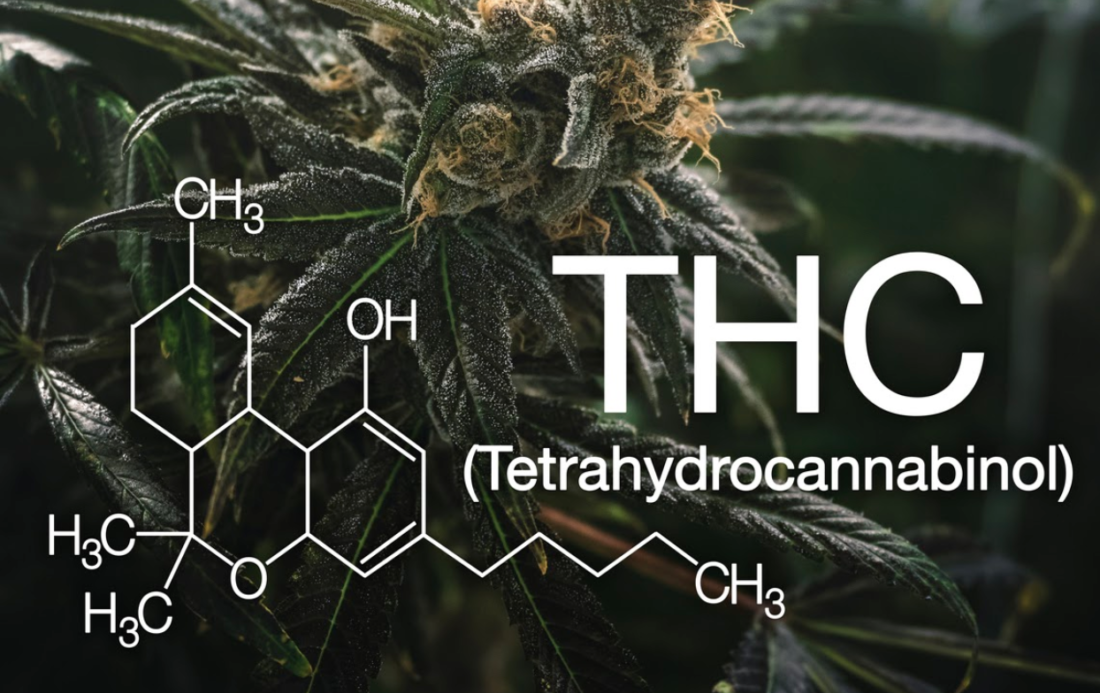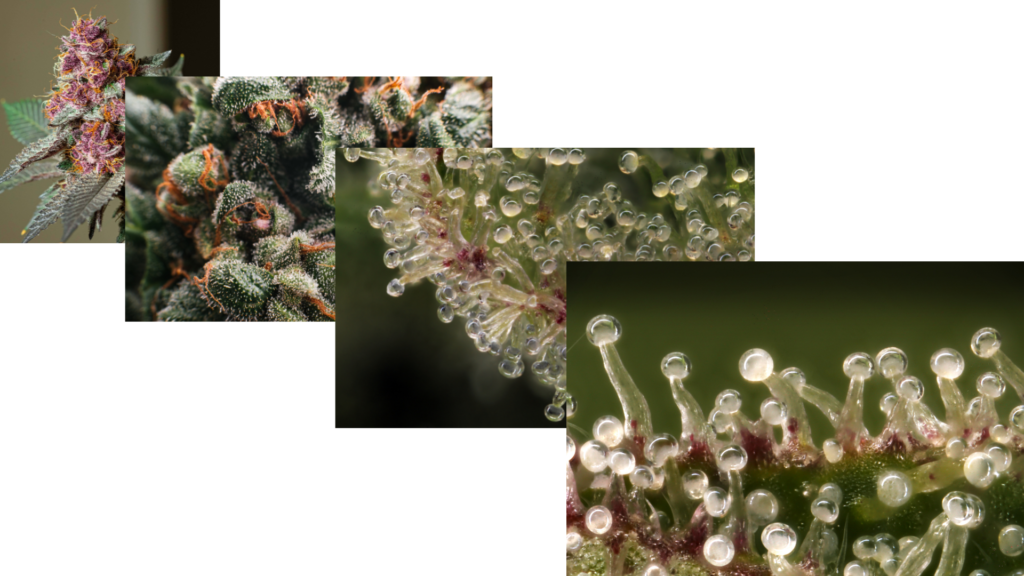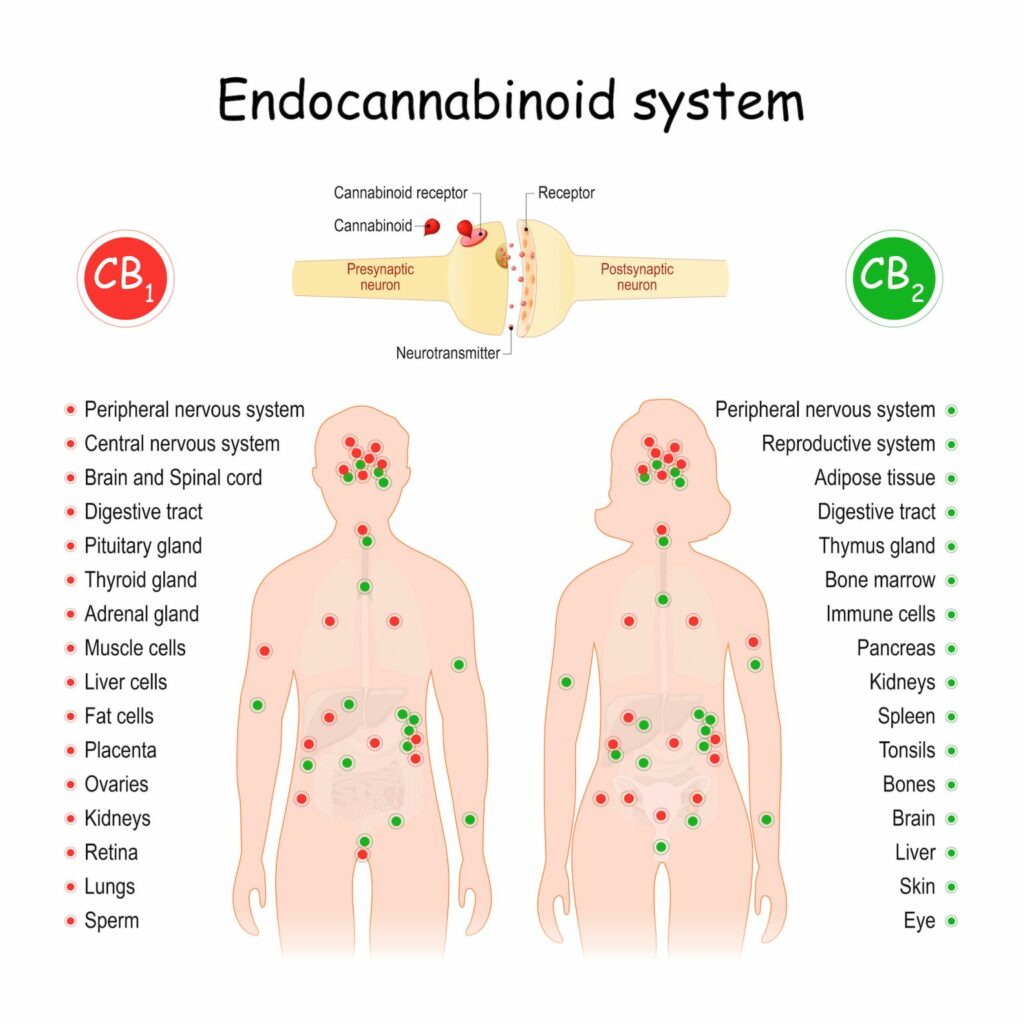This website requires you to be 21 years or older to enter. Please confirm your age below to continue.

Updated December 2022 by Sandy Yanez
THC is the shortened name for delta-9-tetrahydrocannabinol and is one of over 500 different compounds found in the cannabis plant. THC is a cannabinoid and is responsible for the well-known “high” or euphoric effects associated with cannabis use, as well as a multitude of other pharmacological actions.
Where THC begins
All plants have a defense system to protect them from predators and the environment. The cannabis plant uses trichomes. Trichomes are sticky resin glands that sit on the small leaves (sugar leaves) and flowering parts (buds) of the cannabis plant to provide the first line of defense. The trichomes are also where most of the plant’s medicinal properties including cannabinoids and aroma (terpenes) are found.
What are cannabinoids?
Cannabinoids are compounds found in the cannabis plant that interact with the body’s endocannabinoid system (discussed below), which is responsible for a myriad of physiological and cognitive processes.

There are three main types of cannabinoids: phytocannabinoids (e.g. THC & CBD that come from the cannabis plant), endocannabinoids (e.g. Anandamide & 2-AG that our body produces), and synthetic cannabinoids (made in a lab).
Plant-based cannabinoids can interact with our endocannabinoid system due to their similar structure. They interact with cannabinoid receptors to elicit effects that help a variety of functions in the body such as decreasing inflammation, decreasing pain, elevating your mood, aiding memory, and more.
For example, THC binds to the CB1 receptors in your brain and mimics an endocannabinoid (neurotransmitter) our body produces called anandamide. Anandamide is known as our “bliss” molecule and plays a role in our overall health and mental wellness.
When THC binds with CB2 receptors in the body (peripheral nervous system, metabolic tissue, and immune system), it acts like an anti-inflammatory helping to diminish pain and other inflammatory conditions.
How THC works in the body
Within the human body is a highly complex system called the endocannabinoid system (ECS). The ECS is perhaps the most important system involved in establishing and maintaining human health. The ECS is designed to maintain the body’s internal balance or homeostasis and is comprised
of three core components: endocannabinoids our bodies produce (e.g. Anandamide & 2-AG), receptors the cannabinoids bind to (e.g. CB1 & CB2), and enzymes responsible for breaking down endocannabinoids (e.g. FAAH & MAGL).
THC interacts with the body’s cannabinoid receptors, specifically the CB1 receptors. CB1 receptors are found in very high levels in the brain and central nervous system but are also found throughout the body and skin. And since pain, stress, appetite, energy, metabolism, cardiovascular function,

reward, motivation, reproduction, and sleep are all functions of the ECS, THC can affect each one.
After consuming THC, you may experience several short-term effects including an altered perception of time, silly or giddiness, an increase or a lack of focus, relaxation, and a generalized “feel good” through the mind and body. However, overuse of THC can also have unwanted effects like anxiety or rapid heart rate, difficulty thinking, slow reaction time, and even increased depression.
The high of THC
As mentioned THC binds well to CB1 receptors and can take over or modify natural functioning within the brain and body. It’s the CB1 receptors that are responsible for the “high” feeling you get when you have THC in your system.
Once in your bloodstream, THC binds with CB1 receptors setting off a chain of effects, one being the increase of dopamine – which is the actual “high” you feel with cannabis use. This affects several areas including time perception (time may seem to run slower), pleasure, pain, memory, coordination, appetite, etc. The precise effects experienced will depend on the amount of THC consumed as well as the individuals’ tolerance to cannabis and their unique endocannabinoid system. But typically THC produces a hugely euphoric high followed by a long-lasting physical relaxation, known as a ‘body high’.
Medical Benefits and Uses
When dosed appropriately, THC offers multiple medical benefits and can be used to help ease the symptoms and effects of:
The low of THC
Simply put, the lows or cons of THC are generally from the misuse or wrong dose consumed. When we use THC, there is a myriad of effects happening within us. One example, THC increases dopamine to bring about the euphoric effect, but overuse can dampen down dopamine receptors – meaning no euphoria or high effects will be felt. Not only will you lose that effect, but the lack of

dopamine can also bring on depression, problems with memory and concentration, and lower motivation and pleasure.
The effects will vary from person to person depending on several things including your endocannabinoid system, the number of receptors you have available, how much and how often you consume cannabis, and even your liver function and the medications you take. Speaking with a cannabis consultant is the best practice for safe effective THC use.
Take away
Many medical cannabis users find THC is a highly effective multi-purpose medicine. THC-rich medical cannabis is consumed by patients with a wide range of conditions. For some it is highly effective pain relief, for others, it is a useful way to help deal with conditions such as MS, epilepsy, arthritis, etc. But many people simply use THC for its recreational pleasure, relaxation, and stress-relieving properties.
No matter what your reason is for consuming cannabis, PFT has an onsite cannabis consultant available to assist you in finding the best product for your individual needs.
References
Atakan Z. (2012). Cannabis, a complex plant: different compounds and different effects on individuals. Therapeutic advances in psychopharmacology, 2(6), 241–254. https://doi.org/10.1177/2045125312457586
Bloomfield, M. A., Ashok, A. H., Volkow, N. D., & Howes, O. D. (2016). The effects of Δ9-tetrahydrocannabinol on the dopamine system. Nature, 539(7629), 369–377. https://doi.org/10.1038/nature20153
Hirvonen, J., Goodwin, R. S., Li, C. T., Terry, G. E., Zoghbi, S. S., Morse, C., Pike, V. W., Volkow, N. D., Huestis, M. A., & Innis, R. B. (2012). Reversible and regionally selective downregulation of brain cannabinoid CB1 receptors in chronic daily cannabis smokers. Molecular psychiatry, 17(6), 642–649. https://doi.org/10.1038/mp.2011.82
Kendall, D. A., & Yudowski, G. A. (2017). Cannabinoid Receptors in the Central Nervous System: Their Signaling and Roles in Disease. Frontiers in cellular neuroscience, 10, 294. https://doi.org/10.3389/fncel.2016.00294
Mackie K. (2008). Cannabinoid receptors: where they are and what they do. Journal of neuroendocrinology, 20 Suppl 1, 10–14. https://doi.org/10.1111/j.1365-2826.2008.01671.x
Reggio P. H. (2010). Endocannabinoid binding to the cannabinoid receptors: what is known and what remains unknown. Current medicinal chemistry, 17(14), 1468–1486. https://doi.org/10.2174/092986710790980005
Scherma, M., Masia, P., Satta, V., Fratta, W., Fadda, P., & Tanda, G. (2019). Brain activity of anandamide: a rewarding bliss? Acta Pharmacologica Sinica, 40(3), 309-323. https://doi.org/10.1038/s41401-018-0075-x
Tanney, CSC., Backer, R., Geitmann, A., & Smith, DL. (2021). Cannabis glandular trichomes: A cellular metabolite factor. Front. Plant Sci. 12:721986. https://doi.org/10.3389/fpls.2021.721986
Zou, S., & Kumar, U. (2018). Cannabinoid Receptors and the Endocannabinoid System: Signaling and Function in the Central Nervous System. International journal of molecular sciences, 19(3), 833. https://doi.org/10.3390/ijms19030833